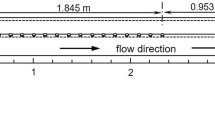Abstract
Velocity and concentration profiles in a pipe flow was measured downstream of injection of a tracer gas at the pipe centerline. The pipe had diameter D = 0.2 m and two Reynolds numbers, Re = 50000 and Re = 100000, were used. The profiles were measured at positions 5D and 10D downstream of the injection point. Three different industrial relevant geometrical configurations were used upstream of the injection point: a 10D straight pipe, two 10D pipes connected with a 90° bend or a straight 10D pipe with a mixer plate mounted 2D upstream the injection point. In all cases, air entered the pipe from the surroundings through a sharp-edged inlet. This represents many practical flow applications and is also a well-defined inlet condition that generates turbulence in the vena contracta in the inlet. The measurements were compared to predictions from three different computational models: two with Reynolds Averaged Navier-Stokes (RANS) and one with high-resolution Detached Eddy Simulation (DES). For RANS, the k-ω SST model had difficulty in predicting the turbulence created by the vena contracta. The k-ε model performed better, but gave completely wrong results for the inlet with a pipe bend. The DES was successful for all cases with only minor deviations from measurements.














Similar content being viewed by others
References
Reynolds O (1883) Proc R Soc London 35(224-226):84
Taylor GI (1922) Proc London Math Soc 2(1):196
Dimotakis PE (2005) Annu Rev Fluid Mech 37:329
Paul EL, Atiemo-Obeng VA, Kresta SM (2004) Handbook of industrial mixing: science and practice. Wiley
Jordan D (1961) Q J Mech Appl Math 14(2):203
Lee J, Brodkey RS (1964) AIChE J 10(2):187
Filmer RW, Yevjevich V (1967). In: Proceedings of 12th congress of the international association for hydraulic research. Colorado State University, pp 115–120
Evans G (1967) J Basic Eng 89(3):624
Clayton CG, Ball A, Spackman R (1968) Dispersion and mixing during turbulent flow of water in a circular pipe. Tech. rep., United Kingdom Atomic Energy Authority, Wantage (England). Research Group
Ger A, Holley E (1976) Journal of the Hydraulics Division p
Guiraud P, Bertrand J, Costes J (1991) Chem Eng Sci 46(5-6):1289
Laufer J (195) NASA reports REPORT 11744
Eggels J, Unger F, Weiss M, Westerweel J, Adrian R, Friedrich R, Nieuwstadt F (1994) J Fluid Mech 268:175
ISO5167-2:2003(E) (2003) Measurement of fluid flow by means of pressure differential devices inserted in circular-cross section conduits running full. International Organization for Standardization
Smith BC (2011) Fundamentals of Fourier transform infrared spectroscopy. CRC Press
Westlye FR (2012) Master Thesis Technical University of Denmark. Emission measurement and exhaust aftertreatment of an ammonia fueled si-engine
Jones WP, Launder BE (1972) Int J Heat Mass Transf 15(2):301. https://doi.org/10.1016/0017-9310(72)90076-2
Launder BE, Sharma BI (1974) Lett Heat Mass Transfer 1(2):131. https://doi.org/10.1016/0094-4548(74)90150-7
Menter F (1994) AIAA J 32(8):1598
Wilcox D (2008) AIAA J 46(11):2823
CD-adapco (2017) STAR-CCM+ Manual. CD-adapco, 11th edn
Weltens H, Bressler H, Terres F, Neumaier H, Rammoser D (1993) Optimisation of catalytic converter gas flow distribution by cfd prediction. Tech. rep., SAE Technical Paper
Johansson Å, Wallin U, Karlsson M, Isaksson A, Bush P (2008) Investigation on uniformity indices used for diesel exhaust aftertreatment systems. Tech. rep., SAE Technical Paper
Acknowledgements
This project was funded by the European Union Horizon 2020 - Hercules-2 - research and innovation program under Grant Agreement No. 634135.
Author information
Authors and Affiliations
Corresponding author
Ethics declarations
Conflict of interests
The authors declare that they have no conflict of interest.
Additional information
Publisher’s note
Springer Nature remains neutral with regard to jurisdictional claims in published maps and institutional affiliations.
Rights and permissions
About this article
Cite this article
Gotfredsen, E., Kunoy, J.D., Mayer, S. et al. Experimental validation of RANS and DES modelling of pipe flow mixing. Heat Mass Transfer 56, 2211–2224 (2020). https://doi.org/10.1007/s00231-020-02835-8
Received:
Accepted:
Published:
Issue Date:
DOI: https://doi.org/10.1007/s00231-020-02835-8




